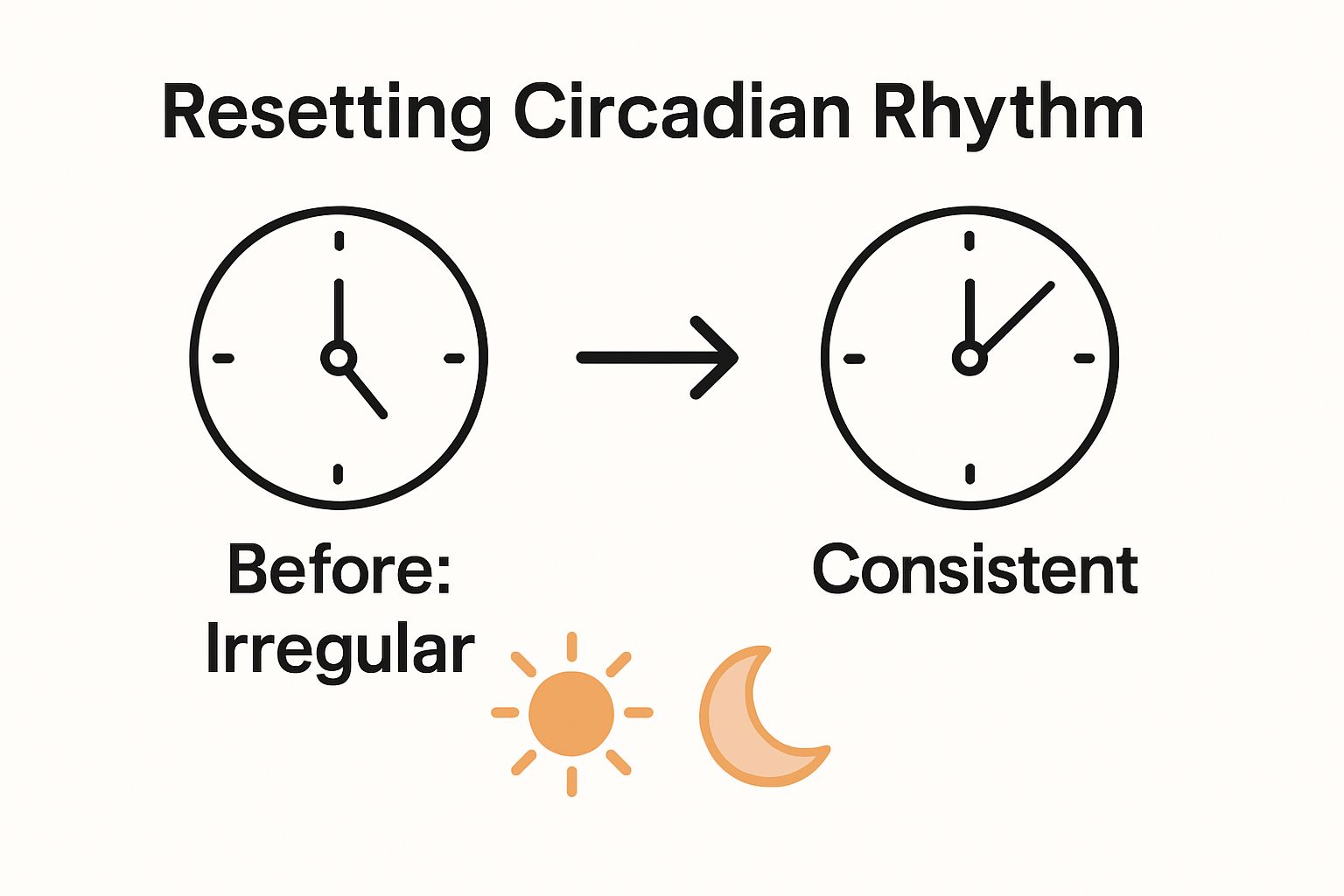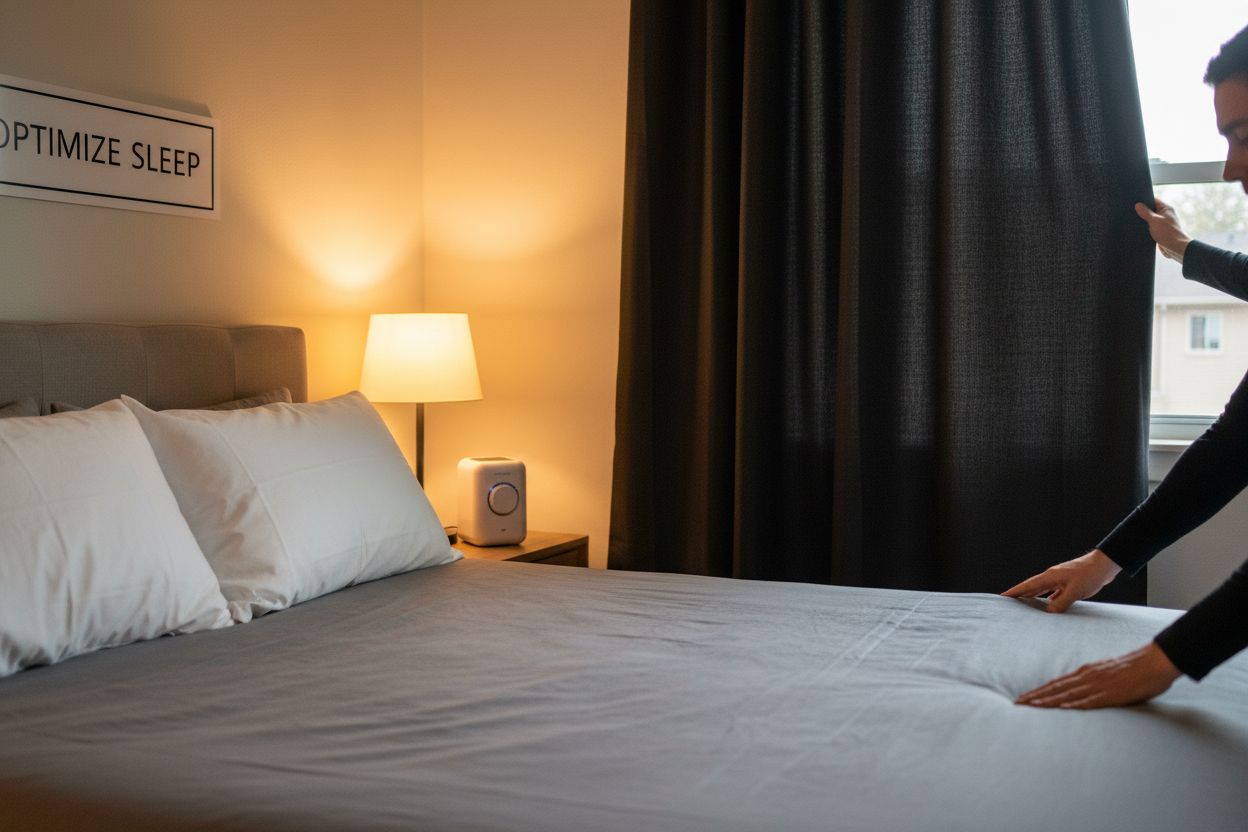Fixing your sleep routine feels impossible when late nights, blue-lit screens, and groggy mornings keep stacking up. Most people do not realize that exposing your eyes to just 15 minutes of morning sunlight can completely reset your body’s internal clock. Yet what surprises many is that the real solution is not about sleeping more hours—it is about when and how you sleep. The timing, not the quantity, can transform your energy and focus in ways most never expect.
Table of Contents
- Step 1: Assess Your Current Sleep Patterns
- Step 2: Limit Electronic Device Usage Before Bed
- Step 3: Establish a Consistent Sleep Schedule
- Step 4: Optimize Your Sleep Environment
- Step 5: Incorporate Natural Light Exposure
- Step 6: Monitor Your Progress and Adjust as Needed
Quick Summary
| Key Point | Explanation |
|---|---|
| 1. Track Your Sleep Patterns | Create a detailed sleep diary for one week to identify habits disrupting your circadian rhythm. |
| 2. Limit Electronic Device Usage | Establish a “digital sunset” two hours before bedtime to enhance melatonin production and sleep quality. |
| 3. Maintain a Consistent Sleep Schedule | Go to bed and wake up at the same time every day to train your internal clock for better sleep. |
| 4. Optimize Your Sleep Environment | Adjust bedroom temperature, lighting, and noise to create a restful sanctuary conducive to sleep. |
| 5. Incorporate Natural Light Exposure | Get morning sunlight and manage artificial light to regulate your sleep-wake cycle effectively. |
Step 1: Assess Your Current Sleep Patterns
Resetting your circadian rhythm begins with a clear understanding of your current sleep landscape. Most people drift through their daily routines without realizing how their habits disrupt their natural sleep cycles. Your body operates on a complex internal clock that can easily become misaligned with natural light and dark patterns.
Tracking Your Sleep Patterns
Start by creating a comprehensive sleep diary for one week. This isn’t just about recording when you go to bed and wake up. You’ll want to capture detailed information about your entire sleep experience. Note the exact times you fall asleep and wake up, any nighttime disruptions, how you feel upon waking, and any external factors that might impact your sleep.
Consider using a simple notebook or a dedicated sleep tracking app to make this process easier. Sleep tracking research suggests that consistent monitoring can reveal patterns you might otherwise miss. Pay attention to these key elements:
- Time you naturally feel tired
- Time you actually go to bed
- Number of times you wake up during the night
- Quality of sleep (restless or deep)
- Morning energy levels
- Caffeine or electronic device usage before bedtime
Your goal is to create a complete picture of your current sleep behavior. This isn’t about judgment - it’s about understanding. Many people discover surprising insights about their sleep patterns that they’ve never recognized before. Some find they’re consistently fighting against their body’s natural rhythm by staying up late or waking up at inconsistent times.
Analyzing Your Sleep Data
After a week of tracking, review your sleep diary with a critical eye. Look for consistent patterns that might be disrupting your natural circadian rhythm. Are you consistently going to bed much later than you feel tired? Do you use electronic devices that emit blue light right before sleeping? Are there irregular work or social schedules interfering with your body’s natural sleep cycle?
This assessment is the critical first step in understanding how to realign your internal clock. By becoming aware of your current sleep patterns, you’re already making significant progress toward resetting your circadian rhythm naturally.
Step 2: Limit Electronic Device Usage Before Bed
Electronic devices are silent saboteurs of your circadian rhythm, flooding your brain with artificial light that tricks your body into believing it’s still daytime. Blue light emitted from screens suppresses melatonin production, the critical hormone responsible for regulating your sleep cycle. Understanding and managing your device usage becomes paramount in resetting your natural sleep patterns.
Begin by establishing a digital sunset approximately two hours before your intended bedtime. This means creating a deliberate boundary between your electronic world and your sleep environment. Start by setting a firm cutoff time for all electronic devices including smartphones, tablets, laptops, and televisions. Place these devices in another room or use dedicated charging stations away from your bedroom to reduce temptation.
Learn more about digital detox strategies that can help minimize electromagnetic interference with your sleep cycles. Consider these practical strategies for reducing electronic exposure:
- Use blue light filtering apps or built-in device settings
- Wear blue light blocking glasses in the evening
- Switch devices to grayscale mode to reduce visual stimulation
- Create a dedicated “power down” routine before bed
If complete device elimination feels challenging, implement gradual reduction techniques. Start by reducing screen time by 30 minutes before bed, then slowly increase this buffer. Replace electronic interactions with calming activities like reading physical books, practicing gentle stretching, or engaging in meditation. These alternative activities not only reduce blue light exposure but also help signal to your body that it’s time to wind down.
Verification of Success
You’ll know this step is working when you start experiencing more natural drowsiness, fall asleep more easily, and wake up feeling more refreshed. Pay attention to how your body responds when you create distance between yourself and electronic devices. The goal isn’t perfection but consistent, incremental improvements in your sleep environment and habits.
Step 3: Establish a Consistent Sleep Schedule
Your body craves rhythm and predictability, especially when it comes to sleep. Establishing a consistent sleep schedule is like programming your internal biological clock to operate with precision. This step is about creating a reliable sleep-wake cycle that your body can anticipate and follow naturally.
Begin by determining your ideal bedtime and wake-up time based on your lifestyle and natural energy patterns. Research from sleep experts emphasizes the importance of maintaining this schedule every single day - yes, even on weekends. Your body doesn’t understand the concept of “sleeping in” and disrupting your carefully established rhythm can undo weeks of progress.
Select a bedtime that allows for 7-9 hours of sleep and feels sustainable with your daily commitments. If you need to wake up at 6:00 AM for work, calculate backward to determine your ideal bedtime. In this scenario, aim to be in bed by 10:00 PM or 11:00 PM. The key is consistency and commitment.
Implement strategies to support your new sleep schedule:
- Set multiple alarms for both bedtime and wake-up time
- Create a wind-down routine that signals to your body it’s time to sleep
- Use consistent lighting and room temperature
- Avoid heavy meals or intense exercise close to bedtime
Recognize that adapting to a new sleep schedule takes time and patience. Your body might initially resist the change, sending signals of sleepiness at odd hours or making you feel alert when you want to rest. This is normal. Stay committed to your chosen schedule, understanding that it can take several weeks for your circadian rhythm to fully recalibrate.
Verification of Success
You’ll know you’ve successfully established a consistent sleep schedule when you start naturally waking up before your alarm, feel more energized throughout the day, and experience improved overall mood and cognitive function. Your body will begin to anticipate sleep and wakefulness, making the entire process feel more intuitive and less forced.
Below is a checklist to help you verify your progress at each phase of resetting your circadian rhythm naturally.
| Step | Verification Criteria |
|---|---|
| Limit Electronic Device Usage | Fall asleep more easily; natural drowsiness in the evening; feeling refreshed upon waking |
| Consistent Sleep Schedule | Wake up before your alarm; improved daytime energy and mood; easier transitions into sleep |
| Optimize Sleep Environment | Fall asleep faster; fewer nighttime awakenings; waking up well rested |
| Natural Light Exposure | Increased daytime energy; feel sleepy at consistent evening times; better overall mood |
| Monitor Progress & Adjust | Sleep becomes predictable; body sends clear signals for sleep and alertness; less struggle with rest |
 Remember, resetting your circadian rhythm is a journey of small, persistent changes.
Remember, resetting your circadian rhythm is a journey of small, persistent changes.
Step 4: Optimize Your Sleep Environment
Your sleep environment is a sanctuary that can either support or sabotage your resetting circadian rhythm efforts. Creating the perfect sleep space is about transforming your bedroom into a dedicated healing zone that signals your body it’s time to rest and recover. This isn’t just about comfort - it’s about designing an environment that communicates with your biological systems.
Understand how environmental factors impact sleep, starting with temperature control. Aim to maintain your bedroom between 60-67 degrees Fahrenheit, the optimal range for triggering your body’s natural sleep response. Cooler temperatures mimic the body’s natural drop in core temperature during nighttime, helping to initiate and maintain deeper sleep cycles.
Darkness and Quiet: Your Sleep Allies
Invest in blackout curtains or an eye mask to eliminate any external light sources. Even small amounts of light can disrupt melatonin production and interfere with your circadian rhythm. If you live in an area with significant noise pollution, consider using white noise machines or earplugs to create an acoustic buffer that promotes uninterrupted sleep.
Your bedding plays a crucial role in sleep optimization. Choose materials that regulate body temperature and wick away moisture. Natural fabrics like cotton and bamboo are excellent choices. Replace your mattress if it’s older than seven years, as worn-out sleeping surfaces can create physical discomfort that prevents quality rest.
Consider these strategic modifications:
- Remove electronic devices from the bedroom
- Use low, warm-toned lighting in the evening
- Invest in comfortable, breathable bedding
- Create a clutter-free sleeping environment
Pay attention to electromagnetic frequencies in your sleeping area. Minimize wireless devices near your bed and consider using EMF protection tools to reduce potential disruptions to your sleep cycle. The goal is to create a calm, peaceful environment that supports your body’s natural healing and restoration processes.
Verification of Success
You’ll know you’ve optimized your sleep environment when you start falling asleep faster, experience fewer nighttime awakenings, and wake up feeling more refreshed. Your bedroom should feel like a sanctuary that invites relaxation and promotes deep, restorative sleep.

Step 5: Incorporate Natural Light Exposure
Natural light is the most powerful synchronizer of your body’s internal clock, acting like a reset button for your circadian rhythm. Sunlight exposure directly influences your brain’s production of melatonin and serotonin, the hormones responsible for regulating sleep and mood. Understanding how to harness natural light becomes a critical strategy in resetting your sleep patterns.
Harvard sleep researchers emphasize the importance of consistent daylight interaction for maintaining a healthy sleep cycle. Begin by creating a morning routine that prioritizes immediate light exposure. Within the first hour of waking, spend at least 15-30 minutes in direct sunlight. If outdoor exposure isn’t immediately possible, position yourself near a window that receives morning sun.
For those with limited outdoor access, consider alternative strategies. Invest in a full-spectrum light therapy lamp that mimics natural sunlight. These devices can be particularly beneficial for individuals working indoor jobs or living in regions with limited daylight. Position the lamp to simulate morning light, directing it towards your face to trigger your body’s wake-up mechanisms.
Develop a structured approach to light exposure throughout your day:
- Take short morning walks outside
- Work near windows when possible
- Use breaks to step outdoors and receive direct sunlight
- Minimize artificial lighting during daytime hours
Understand that light exposure isn’t just about quantity but also timing. Morning light sends a powerful signal to your brain that it’s time to be alert, while gradually reducing light exposure in the evening helps trigger your natural sleep preparation processes. This means actively managing your environment to support your circadian rhythm.
Verification of Success
You’ll recognize progress when you start experiencing more natural energy during daylight hours and find yourself becoming sleepy at consistent evening times. Your body will begin to develop a more intuitive rhythm, with improved mood, increased alertness during the day, and easier transitions into sleep at night. Remember, resetting your circadian rhythm is a gradual process that requires patience and consistent implementation.
Step 6: Monitor Your Progress and Adjust as Needed
Resetting your circadian rhythm is not a linear journey but a dynamic process of continuous adaptation. Tracking and analyzing your progress becomes the critical final step in successfully recalibrating your body’s internal clock. This isn’t about achieving perfection but understanding your unique biological rhythms and making incremental improvements.
Sleep experts recommend maintaining a comprehensive sleep diary that goes beyond simple bedtime and wake-up times. Document not just when you sleep, but the quality of your sleep, energy levels throughout the day, mood fluctuations, and any external factors that might influence your rest.
Create a systematic approach to monitoring your progress. Use a dedicated notebook or a digital tracking app to record detailed information. Note the time you fall asleep, number of nighttime awakenings, how long it takes to fall asleep, and how you feel upon waking. Look for patterns and trends rather than focusing on individual nights.
Establish clear metrics for measuring your circadian rhythm reset:
- Consistent sleep and wake times
- Reduced time needed to fall asleep
- Fewer nighttime disruptions
- Improved morning energy levels
- More stable mood throughout the day
Recognize that setbacks are a normal part of the process. If you find certain strategies aren’t working, don’t view them as failures but as valuable data points. Your body is complex, and what works for one person might not work identically for another. Be prepared to experiment and adjust your approach.
Verification of Success
True success in resetting your circadian rhythm isn’t about rigid adherence to a single method, but about developing a flexible, intuitive understanding of your body’s needs. You’ll know you’re making progress when sleep becomes less of a struggle and more of a natural, predictable process. Your body will start sending clearer signals about when it’s time to rest and when it’s time to be alert. Remember, this is a journey of self-discovery, patience, and gentle, consistent effort.
Break the Cycle: Support Your Sleep Environment Against Hidden EMF
You have worked hard tracking your sleep, managing screen time, and seeking the perfect restful routine. But are you overlooking an invisible disruptor in your environment? The article highlights the crucial role of a calm, tech-free bedroom and warns about electronic interference with your circadian rhythm. Modern wireless devices such as phones, WiFi routers, and laptops constantly emit electromagnetic field (EMF) radiation that science links to poor sleep quality, restlessness, and even health concerns for your heart and blood. If you want to create a sanctuary that truly supports restful sleep, you need more than blackout curtains and quiet—you need protection from EMF exposure too.

Act now to defend your sleep environment and help your body fully recover every night. Explore how our scientifically tested solutions at Omnia Radiation Balancer can bring noticeable benefits to your body strength, blood health, and water structure. Visit our main site to learn how protecting against EMF can complement the steps you took in this article—so that your bedroom becomes a place where deep rest and natural rhythm can thrive. Your best night’s sleep could start tonight.
Frequently Asked Questions
How can I effectively assess my current sleep patterns?
To assess your current sleep patterns, begin by tracking your sleep over a week in a detailed sleep diary. Note your bedtime, wake-up time, nighttime disruptions, and how you feel in the morning to reveal patterns impacting your sleep.
What are the best ways to limit electronic device usage before bed?
Establish a digital sunset by avoiding all electronic devices for at least two hours before bedtime. Create a routine—like reading or stretching—to engage in calming activities instead of screen time to help signal to your body it’s time to wind down.
How do I create a consistent sleep schedule?
To establish a consistent sleep schedule, choose a bedtime and wake-up time that allow for 7-9 hours of sleep, and stick to it every day, even on weekends. Set multiple alarms for bedtime and wake-up time to reinforce this routine.
What changes can I make to optimize my sleep environment?
To optimize your sleep environment, aim for a bedroom temperature of 60-67 degrees Fahrenheit and eliminate any sources of light and noise. Consider using blackout curtains and removing electronic devices to enhance your sleep quality.
How can I incorporate natural light exposure effectively?
Incorporate natural light exposure by spending 15-30 minutes in direct sunlight within the first hour of waking. Try taking short morning walks or sitting near windows to maximize your daylight interaction and support your circadian rhythm.
How can I monitor my progress as I reset my circadian rhythm?
To monitor your progress, maintain a comprehensive sleep diary noting sleep quality, energy levels, and any disruptions. Look for consistent trends rather than individual nights and adjust your strategies as needed for continued improvement.
Recommended
- How Does Wireless Radiation Affect Our Sleep? – Omnia Radiation Balancer
- 5 Easy Ways to Digital Detox From EMF During The Holidays – Omnia Radiation Balancer
- 50 Resolutions For 2022 To Raise Your Vibrational Energy – Omnia Radiation Balancer
- 50 Resolutions to Help Keep Your Energy Balanced in 2021 – Omnia Radiation Balancer
- Erholsamer Schlaf » So optimierst Du Deinen Schlaf ✓



Share and get 15% off!
Simply share this product on one of the following social networks and you will unlock 15% off!